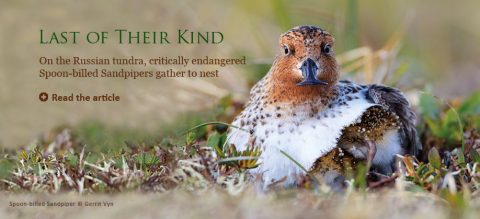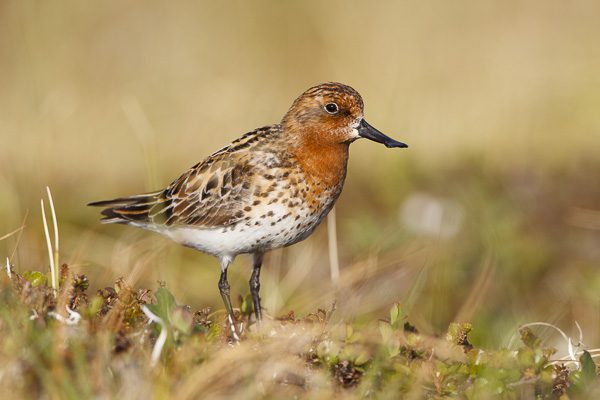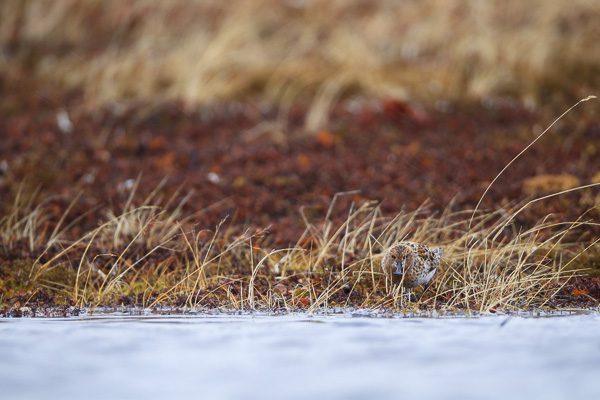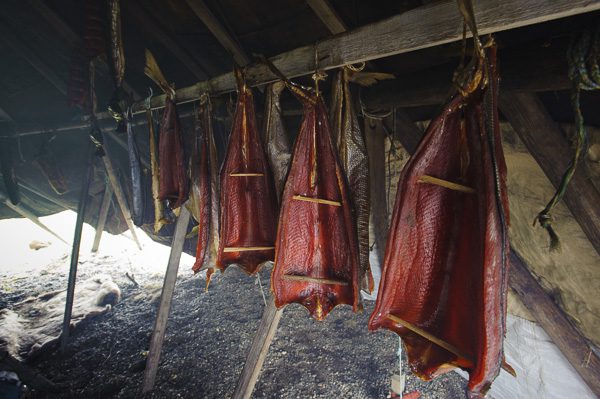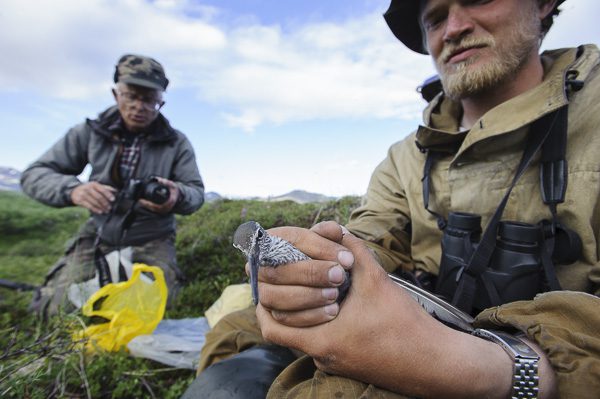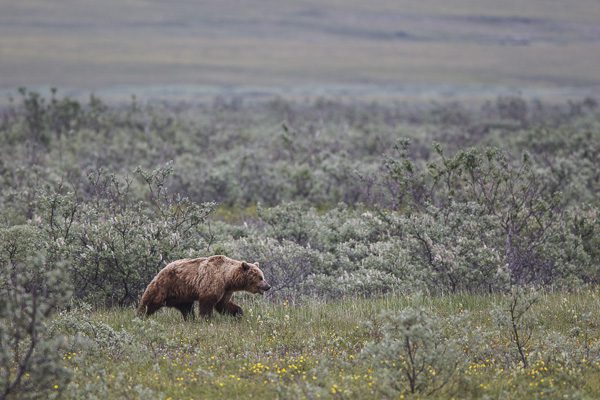Last of Their Kind: On the Tundra With the Endangered Spoon-billed Sandpiper
Text and photos by Gerrit Vyn
January 15, 2013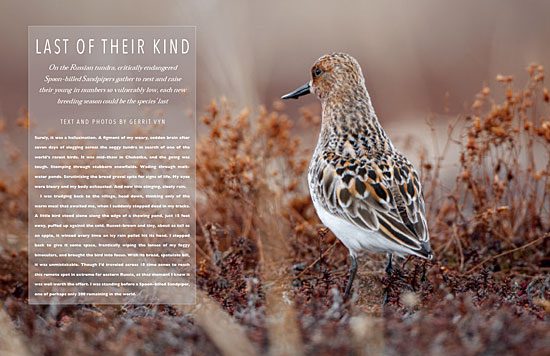
Surely, it was a hallucination. A figment of my weary, sodden brain after seven days of slogging across the soggy tundra in search of one of the world’s rarest birds. It was mid-thaw in Chukotka, and the going was tough. Stomping through stubborn snowfields. Wading through melt-water ponds. Scrutinizing the broad gravel spits for signs of life. My eyes were bleary and my body exhausted. And now this stinging, sleety rain.
I was trudging back to the village, head down, thinking only of the warm meal that awaited me, when I suddenly stopped dead in my tracks. A little bird stood alone along the edge of a thawing pond, just 15 feet away, puffed up against the cold. Russet-brown and tiny, about as tall as an apple, it winced every time an icy rain pellet hit its head. I stepped back to give it some space, frantically wiping the lenses of my foggy binoculars, and brought the bird into focus. With its broad, spatulate bill, it was unmistakable.
Though I’d traveled across 18 time zones to reach this remote spot in extreme far eastern Russia, at that moment I knew it was well worth the effort. I was standing before a Spoon-billed Sandpiper, one of perhaps only 200 remaining in the world.
I had come on an assignment from the Cornell Lab of Ornithology to record the first high-definition video footage ever taken of Spoon-billed Sandpipers on their breeding grounds, as well as to take photographs and high-quality sound recordings for the Lab’s Macaulay Library. I spent nearly every day of June and July 2011 on the Siberian tundra searching for spoon-bills and documenting every phase of their breeding cycle I witnessed. I was with a 10-person expedition crew, made up of ornithologists and conservationists, there to monitor and work to save this critically endangered species.
The global population of Spoon-billed Sandpipers is estimated to be as low as 100 breeding pairs. The species could easily become extinct within the decade, and five years isn’t out of the question. It was a grim realization. I knew that I may well be on a mission to document the final days of a species we barely got to know. These videos, still photographs, and sound recordings might well be the 21st-century digital equivalent of a Passenger Pigeon specimen in a museum. But all of us who took part in the expedition desperately hoped there was yet time to turn around the bird’s catastrophic decline. I wanted my videos and photographs to be more than just a final record of a lost species for the archives. I hoped they would serve as a way to finally introduce this enigmatic and charming species to the world—to enlist peoples’ aid in a global effort to save the Spoon-billed Sandpiper, conserve its flyway, and by extension, to preserve the dozens of other declining bird species that migrate along the East Asian–Australasian flyway.
Theoretically, I could have flown from my home in Seattle to Anchorage to Anadyr, Russia, in half a day—if only there had been direct flights westward. Instead, I had to head east, nearly circumnavigating the globe, from Seattle to New York to Moscow, across all of Russia, and finally to Anadyr. There I spent the better part of 10 days waiting in a little room at the Anadyr airport—for my baggage and gear to clear customs, for the weather to cooperate, for the pilots to feel like flying—before I could board a big, orange helicopter on June 1 and continue to my final destination: Meinypil’gyno, a tiny, isolated fishing village pinned between the shores of the Bering Sea and a vast range of lonesome icy peaks.
My first forays from the village onto the tundra seemed familiar, like being in Alaska again. The typical community of diminutive arctic plants grew all around me. Brown bear tracks wound along coastal lagoons. Much of the bird chorus was familiar, too: singing Snow Buntings, yodeling Pacific Loons, and the staccato rattling calls of Sandhill Cranes flying overhead. Several afternoons I just sat on the shore in amazement watching gray whales surface just 20 feet away, using the coarse beach gravel to rub barnacles off their massive bodies.
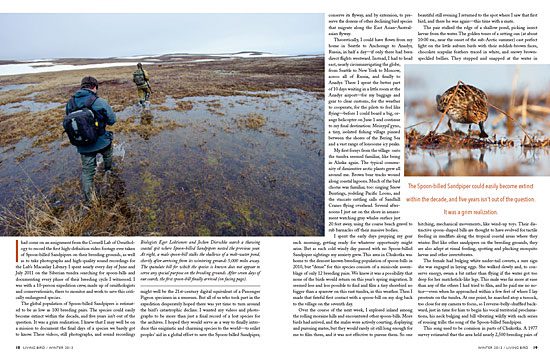
I spent the early days prepping my gear each morning, getting ready for whatever opportunity might arise. But as each cold windy day passed with no Spoon-billed Sandpiper sightings my anxiety grew. This area in Chukotka was home to the densest known breeding population of spoon-bills in 2010, but “dense” for this species consists of a miniscule assemblage of only 12 breeding pairs. We knew it was a possibility that none of the birds would return on this year’s spring migration. It seemed less and less possible to find and film a tiny shorebird no bigger than a sparrow on this vast tundra, in this weather. Then I made that fateful first contact with a spoon-bill on my slog back to the village on the seventh day.

One of perhaps only 200 adult Spoon-billed Sandpipers left. Photo by Gerrit Vyn. 
Anadyr. Capitol of Chukotka. Photo by Gerrit Vyn. 
Team boarding the helicopter for flight to Meinypil'gyno. Photo by Gerrit Vyn. 
Coastal mountains. Photo by Gerrit Vyn. 
Spoon-billed Sandpipers breed in moraine hills and coastal spits like these. Photo by Gerrit Vyn. 
Territory of the Spoon-billed Sandpiper filmed on the nest. Photo by Gerrit Vyn. 
Searching for birds. Photo by Gerrit Vyn. 
This was the first Spoon-billed Sandpiper known to arrive in 2011. Photo by Gerrit Vyn. 
Gerrit Vyn takes a tea break on the tundra. Photo by Gerrit Vyn. 
Camping on the territory of an unpaired Spoon-billed Sandpiper male. Photo by Gerrit Vyn. 
Russian ornithologist Pavel Tomkovich skinning the female Spoon-billed Sandpiper that was found dead. Photo by Gerrit Vyn. 
Coastline near Meinypil'gyno. Photo by Gerrit Vyn. 
Chukchi fisherman. Photo by Gerrit Vyn. 
Drying sockeye. Photo by Gerrit Vyn. 
Two Spoon-billed Sandpipers nested in the foreground of this picture in 2011. Photo by Gerrit Vyn. 
Russian ornithologists banding a Wandering Tattler. Photo by Gerrit Vyn. 
Brown bear in the alders. Photo by Gerrit Vyn. 
Start of the journey home, which took three days overland by Vezdehod. Photo by Gerrit Vyn.
Over the course of the next week, I explored inland among the rolling moraine hills and encountered other spoon-bills. More birds had arrived, and the males were actively courting, displaying and pursuing mates, but they would rarely sit still long enough for me to film them, and it was not effective to pursue them. So one beautiful still evening I returned to the spot where I saw that first bird, and there he was again—this time with a mate.
The pair stalked the edge of a shallow pond, picking insect larvae from the water. The golden tones of a setting sun (at about 10:00 P.M., near the onset of the sub-Arctic summer) cast perfect light on the little auburn birds with their reddish-brown faces, chocolate scapular feathers traced in white, and snowy brown-speckled bellies. They stepped and snapped at the water in hitching, mechanical movements, like wind-up toys. Their distinctive spoon-shaped bills are thought to have evolved for tactile feeding in mudflats along the tropical coastal areas where they winter. But like other sandpipers on the breeding grounds, they are also adept at visual feeding, spotting and plucking mosquito larvae and other invertebrates.
The female had bulging white undertail coverts, a sure sign she was engaged in laying eggs. She walked slowly and, to conserve energy, swam a bit rather than flying if the water got too deep for her matchstick-like legs. This male was far more at ease than any of the others I had tried to film, and he paid me no notice—even when he approached within a few feet of where I lay prostrate on the tundra. At one point, he marched atop a tussock, too close for my camera to focus, so I reverse-belly-shuffled backward, just in time for him to begin his vocal territorial proclamations, his neck bulging and bill vibrating wildly with each series of rousing trills: the song of the Spoon-billed Sandpiper. This song used to be common in parts of Chukotka. A 1977 survey estimated that the area held nearly 2,500 breeding pairs of Spoon-billed Sandpipers. Three decades later, an expedition by the Russian Academy of Sciences found that they had dropped in numbers by more than 50 percent to about 1,000 pairs. Follow-up surveys have subsequently shown a full-fledged population collapse, down to around 500 pairs by 2003. In 2004, the International Union for Conservation of Nature changed the species status from vulnerable to endangered on its Red List, then again to critically endangered in 2008. By 2009, the population had further slipped to just 200 pairs.
“My opinion is that this is the capital of the Spoon-billed Sandpiper’s homeland,” Evgeny Syroechkovskiy told me one afternoon as we sat together on the tundra. The director of Birds Russia, Syroechkovskiy is a veteran of more than a decade of expeditions to the tundra to gather data about Spoon-billed Sandpiper nesting. His findings have been heartbreaking.
“This place [around Meynypil’gyno] was never visited by ornithologists before, but we identified it from satellite images and maps as habitat where Spoon-billed Sandpipers are likely to be. And they found 60 to 80 pairs here in 2001, which was amazing…but we’re not speaking about more than about 10 or a maximum of 15 pairs here at the moment. All of the places we have checked in the past 10 years have either shown a declining trend or complete disappearance. The second-best known location is basically gone—only one pair left, and not every year. And everywhere shows a similar trend.”
With late nights and early mornings the best for filming, days provided the best chance for me to sleep. One afternoon, a member of the team burst into the house and announced that they had found a Spoon-billed Sandpiper nest—but it had been raided by a predator. Tragically, the female was dead and her eggs had been broken and eaten.
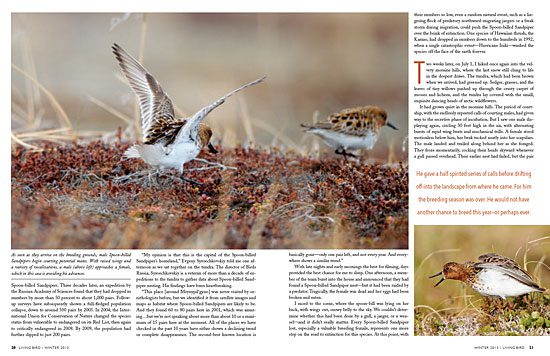
I raced to the scene, where the spoon-bill was lying on her back, with wings out, snowy belly to the sky. We couldn’t determine whether this had been done by a gull, a jaeger, or a weasel—and it didn’t really matter. Every Spoon-billed Sandpiper lost, especially a valuable breeding female, represents one more step on the road to extinction for this species. At this point, with their numbers so low, even a random natural event, such as a lingering flock of predatory northward-migrating jaegers or a freak storm during migration, could push the Spoon-billed Sandpiper over the brink of extinction. One species of Hawaiian thrush, the Kamao, had dropped in numbers down to the hundreds in 1992, when a single catastrophic event—Hurricane Iniki—washed the species off the face of the earth forever.
Two weeks later, on July 1, I hiked once again into the velvety moraine hills, where the last snow still clung to life in the deepest draws. The tundra, which had been brown when we arrived, had greened up. Sedges, grasses, and the leaves of tiny willows pushed up through the crusty carpet of mosses and lichens, and the tundra lay covered with the small, exquisite dancing heads of arctic wildflowers.
It had grown quiet in the moraine hills. The period of courtship, with the endlessly repeated calls of courting males, had given way to the secretive phase of incubation. But I saw one male displaying again, circling 30 feet high in the air, with alternating bursts of rapid wingbeats and mechanical trills. A female stood motionless below him, her beak tucked neatly into her scapulars. The male landed and trailed along behind her as she foraged. They froze momentarily, cocking their heads skyward whenever a gull passed overhead. Their earlier nest had failed, but the pair was clearly bonded, and perhaps the male would be able to coax the female into trying to breed one more time this season.
Another male flew onto the scene, causing a disruption with his displaying and vocalizing. As his rival landed near the female, the first male hopped onto a tussock, craned his head forward, and delivered a steady bout of rhythmically repeated trills. He then gave chase, and the intruder departed.
Soon, yet another male arrived, this one with a pale frosted face. I recognized him as the mate of the female that had been killed only a few hundred feet away over the next hill. He gave a half-spirited series of calls before drifting off into the landscape from where he came. For him, the breeding season was over. He would not have another chance to breed this year—or perhaps ever.
I’d been keeping vigil in a wind-battered blind, huddled in my sleeping bag, monitoring a spoon-bill nest with eggs that were ready to hatch. I was hoping to gather the first film and audio recordings ever taken of newly hatched Spoon-billed Sandpiper chicks. A microphone hidden in nearby sedges allowed me to listen in on the nest.
Around 3:00 A.M., with the July sun barely poking above the tundra horizon, the first chick hatched, followed by another later in the morning. The father soon arrived and traded places with the mother, beginning his half-day shift at the nest. The tiny chicks stayed safe and warm under the adult, protected from the icy winds blowing constantly across the tundra.
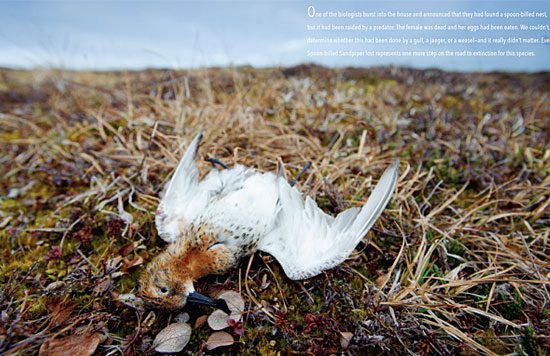
As I listened the following day, the hungry chicks started peeping with more intensity. I knew something was about to happen. Focusing my camera on the nest, I saw two chicks come bubbling out from beneath the father’s breast. These two mottled fluffballs stumbled out and began picking at things in the tundra—their first attempt at foraging. (Spoon-billed Sandpiper chicks are precocial, and from day one they feed themselves.) The chicks returned to their father every 5 to 10 minutes to nestle back under him and warm up. If a hatchling strayed too far, the father gave a jumbled series of calls to beckon it back to the nest. A stern jrrrtwarned the chicks of danger overhead, and they would freeze in their tracks.
That evening the mother returned with a series of trills, announcing another changing of the guard. It would be the last such exchange. The two oldest chicks were ready to leave the nest, and they followed their father out onto the tundra. It was unnerving to watch them wander off. Their tiny bodies looked so delicate, so vulnerable, it seemed a wonder that any of them could survive.
According to researchers, low recruitment is responsible for the Spoon-billed Sandpiper’s population decline—there are simply not enough young birds entering the breeding population to replace the older birds as they die. But the declines don’t appear to be related to any problems here on the Russian breeding grounds. The fact that the species has declined over its entire breeding range points to problems elsewhere, on their wintering grounds and migration routes.
Soon after the last chicks leave the nest, the female will depart on her migration south. And in another few weeks, the father will depart, too, leaving the chicks on their own to begin their first migration in mid-August.
When they lift off to fly south, young spoon-bills follow a flight plan that has been etched into their DNA during the countless millennia of their evolution. Their brains are hard-wired to direct them to stopover sites along the way, where they can rest and feed and replenish their energy, following a route known collectively as the East Asian–Australasian flyway. But these vital waypoints along their 5,000-mile journey aren’t the same as they were 100 or even 5 years ago. And evolution can’t keep up with the pace of this change.
No place on their migratory pathway is more important to the Spoon-billed Sandpiper than the wetlands and intertidal mudflats of Asia’s Yellow Sea, but the area is rapidly being converted from natural habitat to agricultural and other commercial uses, such as rice paddies, saltpans, and aquaculture, damaging all of the ecological systems on which both wildlife and humans depend. An estimated 51 percent of China’s and 60 percent of South Korea’s coastal wetlands have already been lost, and development continues unabated.
Through its devastating population crash, the tiny Spoon-billed Sandpiper is telling us that the Yellow Sea is rapidly passing the tipping point. In the words of a recent report by the International Union for Conservation of Nature, “Unless major steps are taken to reverse current trends, the East Asian–Australasian flyway is likely to experience extinctions and associated collapses of essential and valuable ecological services in the near future.”
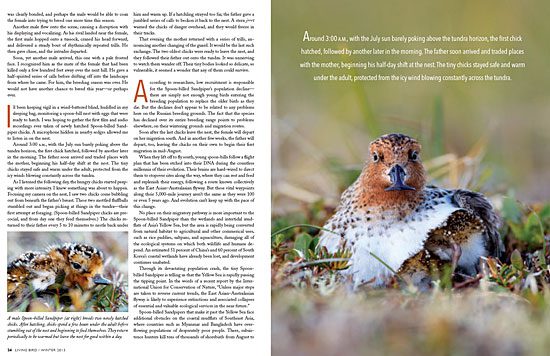
Spoon-billed Sandpipers that make it past the Yellow Sea face additional obstacles on the coastal mudflats of Southeast Asia, where countries such as Myanmar and Bangladesh have overflowing populations of desperately poor people. There, subsistence hunters kill tens of thousands of shorebirds from August to April each year. After they are netted, the birds are either eaten immediately or sold in the market, where a tiny Spoon-billed Sandpiper will fetch the equivalent of 25 cents. A small island in Bangladesh’s Lower Meghna Delta once held the most Spoon-billed Sandpipers ever found anywhere—202 birds in a single count in 1989—but the last survey in 2006 found only 11 spoon-bills in all of Bangladesh.
More than half of the remaining spoon-bill population is believed to winter in Myanmar’s Bay of Martaban. One banded spoon-bill seen there in 2003 was identified as a bird born in the moraine hills near Meinypil’gyno. There, too, hunters take a toll on the global population; several of them interviewed by biologists have confirmed spoon-bill kills among their catch.
But efforts in the Bay of Martaban also show the promise of a better way forward. Starting in 2010, the Spoon-billed Sandpiper Task Force, an international partnership of scientists and conservationists, secured agreements with many local hunters to stop shorebird netting in the bay. Hunters were provided with fishing gear and livestock in exchange for switching to different sources of food and income.
It’s a small step, especially considering the rapid deterioration of the spoon-bill’s migratory corridor, but a small step forward is better than a giant step backward. And small steps are desperately needed right now, as Evgeny Syroechkovskiy told me.
“Returning to some of these great sites in the Arctic where we used to have good numbers of Spoon-billed Sandpipers, and then finding nothing, is very sad—almost like losing a part of your body,” he said. “I personally decided to dedicate a serious part of my life to trying to change the situation for the Spoon-billed Sandpiper. Because if we will not do it, who will? If we all work together, all of our small efforts combined can gradually help change the world for the better.”
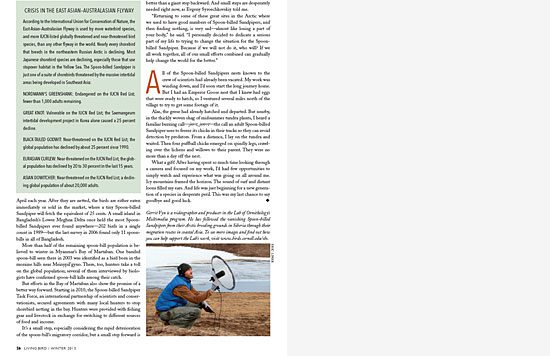
All of the Spoon-billed Sandpipers nests known to the crew of scientists had already been vacated. My work was winding down, and I’d soon start the long journey home. But I had an Emperor Goose nest that I knew had eggs that were ready to hatch, so I ventured several miles north of the village to try to get some footage of it.
Alas, the geese had already hatched and departed. But nearby, in the thickly woven shag of midsummer tundra plants, I heard a familiar buzzing call—jrrrt, jrrrrt—the call of an adult Spoon-billed Sandpiper uses to freeze its chicks in their tracks so they can avoid detection by predators. From a distance, I lay on the tundra and waited. Then four puffball chicks emerged on spindly legs, crawling over the lichens and willows to their parent. They were no more than a day off the nest.
What a gift! After having spent so much time looking through a camera and focused on my work, I’d had few opportunities to simply watch and experience what was going on all around me. Icy mountains framed the horizon. The sound of surf and distant loons filled my ears. And life was just beginning for a new generation of a species in desperate peril. This was my last chance to say goodbye and good luck.
About the Author
Gerrit Vyn is a videographer and producer in the Lab of Ornithology’s Multimedia program. He has followed the vanishing Spoon-billed Sandpipers from their Arctic breeding grounds in Siberia through their migration routes in coastal Asia. To see more images and find out how you can help support the Lab’s work, visit www.birds.cornell.edu/sbs.

All About Birds
is a free resource
Available for everyone,
funded by donors like you
American Kestrel by Blair Dudeck / Macaulay Library
